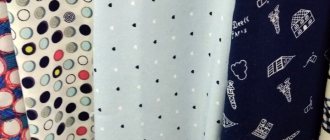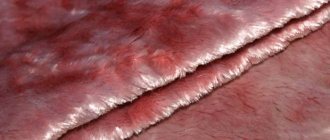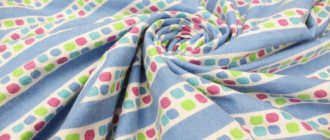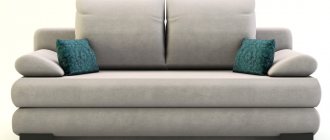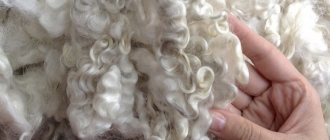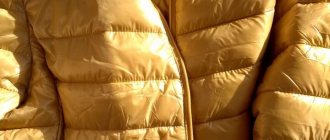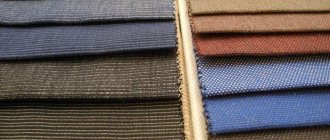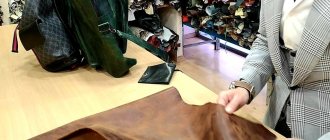This is interesting: Velor originally appeared in the East as a replacement for more expensive velvet. Even the French name velours means “velvet”. The Latin version of villosus is translated as “shaggy,” fluffy.”
Let's talk about production technologies
To make soft, velvety fabric, warp weaving is used. This technology comes in two types:
- Single panel. A special rod is inserted under the threads of the pile being formed. This is how loops are made. After fixing them, the rod is removed. The resulting pile is called looped. If you cut the loops, you get a cut pile.
- Double-sheet. Warp and weft threads create 2 independent fabrics.
- Between them the pile base is located in a zigzag pattern. This layer is cut using knives. The result is a fabric woven from 5 threads.
Fabrics with looped pile are elastic and stretch well. They are mainly used to make clothing. The scope of application of materials with cut pile is more extensive. It is found in home and automotive decor.
What type of fabric is this?
This material includes a group of fleecy fabrics, but generally velor is a velvety, homogeneous textile with soft pile on the surface.
Velor colors
It is made using warp pile, the second of two possible pile weaving techniques. The material is obtained in the form of one or two sheets. There are two ways to produce velor:
- A two-layer fabric of five threads is used (two warp, two weft and one connecting). It is cut lengthwise into two parts with special knives, and a fabric with one smooth and one fleecy side is obtained. This velor is called two-sheet.
- Woven with many loops (formed due to the inserted rod), the fabric is cut and combed, obtaining a fluffy and thick pile. This type of textile is called “loop”, it is elastic and is used in tailoring. If the loops are cut, split velor is formed; if not, looped velor is formed.
Variety of composition
Initially, velor was made from silk. The fibers were also silk. During the production process, metal threads with a touch of gold and silver were added, which made it possible to create luxurious canvases that emphasized the high status of the owner. Products made from this fabric were available only to members of the aristocracy. Gradually, other raw materials began to be used. The material became publicly available, but did not lose its respectability and chic appearance. Today on the textile market you can find velor with a wide variety of compositions.
Cotton
The cotton base explains the hygiene of the fabric. It allows air to pass through well, absorbs moisture, preventing sweat from accumulating on the body, and eliminates the greenhouse effect. Cotton velor is heterogeneous in its structure. This group has its own varieties.
Velor knitwear
Excellent stretch, retains heat. There are 2 types:
- With interlacing fibers and threads.
- With the connection of loops of various shapes.
Knitwear includes plush and corduroy. Ideal for sewing children's clothes and tracksuits.
Velor terry
This variety can be found in any apartment. Often used as bath accessories: large towels, bathrobes, sheets.
Please note: Artificial threads (up to 25%) can be added to the composition of cotton velor. They increase the wear resistance of natural fibers.
Woolen
The basis is made of cloth yarn. It is not combed out; the result is a low, but thick, fluffy pile. Can be pure wool or mixed. Ideal raw material for demi-season outerwear and warm hats. An example would be felt. This group also includes several varieties.
Drape velor
It is distinguished by the highest quality class among all wool representatives. Merino sheep wool is used to make it. Weaving is done using the satin method. The fabric is thin and has great tensile strength. Luxury material that is very expensive.
Velor yarn
This is not canvas, but reinforced cotton threads with pile. The villi are attached in a special way. When the threads are twisted in factories, fibers are blown onto the threads using an air flow. They are permanently fixed at right angles. The material is intended for the manufacture of children's toys and various types of handicrafts. It is better to knit from yarn with knitting needles, as the hook will cause inconvenience.
Important: Velor yarn (its other name is chenille) does not hold its shape, patterns (elastic bands, braids) are not visible on it, but sweaters and jackets made from it keep you warm no worse than pure wool products. This is due to its high heat-conducting properties.
Synthetic
It is based on artificial threads: lycra, polyester, elastane. They can appear in different combinations and ratios. Velor synthetics have become widespread due to their high performance properties. It lasts a long time, does not tear, and is easy to clean. Such fabrics are not suitable for clothing, but they are indispensable for covers and car upholstery.
Microliner
It belongs to synthetic velor, but stands out in a separate category. The best artificial material. Its main properties are external aesthetics, abrasion resistance, moisture permeability, and pleasant tactility.
Leather
The raw material is leather that has flaws on the front side. Such defects do not affect the quality characteristics. It is polished and treated with chrome compounds. Products made from velor leather look stylish and enjoy a long service life.
Attention: Leather varieties are often confused with suede and nubuck, but they have different properties. A lower quality and cheaper analogue is split velor, from which workwear and mittens are made.
Fur
They are also made from animal skin. This is the inner layer - melon. Of all the layers of the skin, it is the least valuable. However, special processing, grinding, which gives the pile uniformity, and coloring increase its aesthetic qualities. A typical example is the outer surface of sheepskin coats.
Compound
Speaking about pile weave fabrics, let us note an important detail: the type of material is determined by its structure, not its composition. In other words, any raw material can be used for production: natural, artificial, synthetic and mixed. According to GOST, fabrics can be cotton, silk or viscose, polyester, wool, in general, different.
But the weaving methods to obtain the required woven structure differ. Today's textile industry uses three main methods:
- mechanical napping (combing), in which the surface of the fabric is mechanically combed, forming the necessary hairs (this is how soft and delicate cotton fabrics are obtained, for example, flannel or flannel);
- weft-pile (or weft pile), involving one warp of fabric and two wefts. The first weft, intertwined with the warp, forms the canvas itself, and the second creates the so-called flooring, or long loops, which are then cut into pile (corduroy, semi-velvet, corduroy, plush);
- base-pile (or pile-on-base). Such fabrics are divided into single-layer and double-layer. In the first, the pile is formed from warp fibers, which are pulled outward using a special metal rod (velvet, faux fur, terry textiles). The latter are obtained from two canvases that have one common base, cut into hairs.
Note that the warp pile method is usually used for the production of silk or woolen fabrics, and the weft pile method is used for cotton fabrics.
Section of pile weave fabric: a) – weft weave; b) – warp weave, two-sheet method; c) – warp weave, rod method
The density of pile materials, as well as the composition, is completely different. Often these are light, delicate textiles, but there are also denser options. Depending on the named indicator, textiles can be used to make a variety of clothes from dresses to coats, curtains, furniture upholstery, etc.
This many-sided velor: main types
The soft, fleecy material is available in various variations. There are many groups and species. Numerous classifications are based on different criteria.
Classification by weave
In the production of velor fabrics, different weaving methods are used, so they differ significantly in appearance.
| Weave | Description |
| Knitted | A distinctive feature is that the base is not woven, but knitted. This explains the good elasticity, which allows you to create beautiful, soft draperies. |
| Satin | The long overlap of the threads allows you to get a sliding, shiny surface. The base predominates. There is one weft thread for every 4 warp threads. |
| Moiré | Characterized by heterogeneous pile. It has different lengths and directions. The result is a special pattern that is clearly visible when the lighting changes. |
| Jacquard | When weaving, different types of threads are used. Silk or lurex can be added to cotton ones. The result is a canvas with repeating, original rapports. This material is relevant for decorative purposes. It can often be found as furniture upholstery. |
Classification by texture
The fabric is also variable in appearance. The pile on it is located differently. Highlight:
- Smooth velor. Has a uniform front side. The villi are located vertically (up from the base).
- Shaped. The pile is uneven; alternation of fleecy and smooth areas is noticeable on the surface.
- Embossed. The figuratively arranged fibers represent an intricate pattern.
- Crash. The pile is dense, giving the canvas a visual bruised effect.
- Corrugated (maybe pleated). Characterized by clearly visible small folds.
Please note: Crash texture can be achieved by using natural and man-made fibers with a high polyester content (which makes up the majority). Corrugation is obtained from mixed synthetic fibers - viscose, polyamide, polyester in equal parts. Such fabrics necessarily contain a small percentage of elastane.
Classification by purpose
The use of velor is largely explained by its composition and properties. It is divided into several types:
- Dress. The name is quite arbitrary, since not only dresses are made from such fabric, but also suits, dressing gowns, and children's clothes. A distinctive feature is the natural composition. It is this that ensures comfortable use. Such products are warm and cozy.
- Interior. The fabric has also found its place among various home textile accessories. Velor curtains look expensive and elegant. The deep tones of the canvas are complemented by a stylish shine. These curtains are thick, drape well, forming soft folds.
- Furniture. Made from durable threads. It is wear-resistant and crease-resistant. Suitable for furniture with complex shapes, as the elastic fabric stretches well. Sometimes they are treated with special compounds, and the result is a vandal-proof fabric that perfectly protects against attacks by pets. Most often it is a mixed fabric. Although there are wool or silk upholstery.
- Automotive. It is used for reupholstering car interiors and for sewing seat covers. Must undergo additional processing. As a result, the material receives dirt- and moisture-proof properties.
Please note: The cost of velor varies widely. The cheapest varieties, made of 100% polyester, are produced in Turkey, Vietnam, and China. Italian canvases are considered elite. They contain a minimum of artificial additives and are manufactured using innovative technologies using modern equipment. Prices may vary by 5-6 times.
A few words about colors
The color palette is varied. Dark colors look stylish. Lightness and romance, despite the solidity of the material, emanate from pastel shades. There are bright, catchy colors.
The canvases differ in the method of dyeing. There are:
- Plain painted. They look graceful and elegant. They are characterized by an interesting play of light. Either ready-made material or threads are dyed.
- Printed. Otherwise they are called printed (with a pattern). A printing machine uses stencils and cliches to apply a pattern to the surface of the fabric.
Please note: Velor holds dyes well, so it retains the brightness and richness of colors for many years. It does not fade, does not fade.
Properties
Fleecy fabric has become widespread due to its impeccable properties. Among them:
- Breathability. Even synthetic varieties provide good ventilation due to special weaving.
- Hygroscopicity. The material absorbs moisture well, while, like cotton, it remains dry for a long time.
- Thermal insulation. The space between the fibers plays the role of an air cushion, which does not allow cold air to pass through and retains heat well. You will never freeze in such clothes.
- Resistance to deformation. Varieties with a woven base do not stretch at all, but those with a knitted base quickly restore their original shape.
- Inert to ultraviolet light. The sun's rays will not harm matter. This is especially true for curtain fabrics. They may undergo additional processing to enhance this feature.
In addition, the material is wrinkle resistant. If a slight bruise occurs, it usually smooths out on its own, without additional effort.
Fabric with peach skin surface
A typical feature of these fashionable materials, which are also sold under the French name “Peau de pêche” or “duvetin,” is a velvety-soft surface that resembles the delicate skin of a peach to the touch. Their secret is that during the finishing process they are subjected to special sanding.
Trench coat and allies: fashionable “outfit” for spring 2020
Parka Burda Style 9/2014 #118
The whole set of advantages
Velor attracts consumers with many advantages:
- Aesthetic appearance. It is not for nothing that previously only representatives of the noble class could wear clothes made from it. The material looks great. Additional attractiveness is provided by the play of halftones and muted shine.
- Good tactile sensations. The fabric is pleasant to the touch. I want to touch her all the time.
- Hypoallergenic. The fabric varieties from which products are made for going out or for home use do not contain synthetics, or they are present in small quantities. As a result, such material does not irritate or chafe the skin.
- Long service life. Natural velor cannot be called durable, but compared to other pile fabrics it is more wear-resistant. Things made from it can last up to 5 years even with intensive use. Especially with proper care.
- Practicality. The fabric is easy to clean, after washing it does not shrink, does not stretch, and retains its original appearance.
For reference: Thanks to its positive characteristics, the material has found its place in the production of children's clothing. Velor is safe even for newborns. Velvety and softness do not irritate children's skin, and breathability and moisture absorption prevent diaper rash and all kinds of skin diseases in babies. For example, prickly heat.
What are these materials used for?
Thus, all types of fabric with long and short pile are characterized by the following characteristics: wrinkle-resistance, soft pleasant texture, durability, non-wear, strength, elasticity, do not lose shape.
Used for sewing clothes, upholstery, etc. Nap fabrics require special care and careful use.
You might be interested in Description of fabric density: choosing the best one for bedding
Modern times are full of different types of materials with pile; they are easy to sew, practical and do not require special care. Any item made of fabric looks beautiful and expensive.
Briefly about the disadvantages
Despite a long track record, some properties of the fabric cause dissatisfaction among customers. The disadvantages include:
- The special structure of the material helps attract dust, hair and threads stick to the surface.
- Sometimes the villi can form creases, which are especially noticeable against a dark background under bright lighting. This does not affect the quality of the products in any way, but they do lose aesthetics. Things look sloppy and untidy.
- Fleecy materials do not tolerate ironing well. Softness and lightness disappear. Their appearance may not change for the better.
To avoid these shortcomings, you must treat products made from this fabric with care. Learn all the nuances of proper care. Sometimes velor is treated with special compounds to protect it from dust. This is true for automotive and furniture varieties.
Application
Velor is applied:
- for sewing adult clothing : dresses, women's tracksuits, hats, gloves;
- for the production of home clothing : suits, pajamas, bathrobes;
- for sewing children's clothing , including for infants: suits, sweatshirts, overalls, rompers, sweaters, dresses;
- shoe velor is used in the production of footwear;
- curtain velor is used in the interior; it makes elegant curtains, theatrical draperies and curtains;
- furniture velor is used for upholstery of upholstered furniture: armchairs, sofas, ottomans, chairs;
- Automotive velor is treated with a special impregnation, making the material resistant to dirt and abrasion; car seat covers are made from it.
Scope of application
Today, fabric is in demand in various areas of life. This is explained by its operational characteristics and availability. The material can be purchased at any fabric store.
| Scope of application | Examples |
| Manufacture of wearing apparel | For this purpose, cotton or wool velor is used. They sew from it:
|
| Shoes | Some types are used to make shoe uppers. Microliner is great for making insoles. It absorbs moisture well, and your feet feel comfortable in such shoes. This eliminates the occurrence of fungus. |
| Leather goods | You can find stylish bags and clutches made of leather varieties. Light shine combined with original fittings and decorative finishing make them real works of art. |
| Interior | Beautiful curtains for the living room, bedspreads and capes are made from velor. Decorative thought pillows look impressive and become a bright accent in the design. |
| Automotive industry | Velor seat covers look sophisticated and last a very long time. In addition, this lining prevents slipping. Some interior parts can also be decorated with this fabric. |
| Furniture manufacturing | Upholstering sofas and armchairs with this material will add luxury to upholstered furniture. The upholstery fabric is suitable for traditional and custom products. |
| Kids toys | Soft dogs and cats made of velor are absolutely safe. They are environmentally friendly and cannot harm the child in any way. And their velvety nature makes them favorites of little ones, because with such a faithful friend it is so comfortable to fall asleep and joyfully wake up. |
| Needlework | Knitted yarn - chenille - is suitable for this purpose. She is loose and fluffy. It is used for embroidery. In addition, craftswomen make beautiful knitted crafts from it. |
For reference: Every year velor finds new uses. Not so long ago they began to use it to decorate caissons (recesses and niches).
Video review of cotton velor
In this video you will learn what Italian cotton velor in dark blue with a herringbone print looks like, see the texture and short pile. This material is great for sewing dark suits, dresses, skirts, and trousers. The cost of such material is about 690 rubles.
See similar articles
- Oxford - fabric for real men
- Ribana - knitted fabric, natural and tight
- Linen is a natural and eco-friendly fabric
- Bamboo is an eco-friendly fabric for clothing and home textiles
- Felt - wool fabric for needlework and hats
- Diving - close-fitting viscose fabric
If you liked the article, share it with your friends!
Proper care is the key to longevity
Luxurious fabric loves extra attention. The more carefully you treat her, the better she will look.
Clothes care
Includes 2 main procedures:
- Wash. Choose only delicate mode and a temperature no higher than +30 degrees. The material does not like to be twisted. If you use a machine spin, set the minimum speed.
- Drying. It is recommended to dry the product in natural conditions, but in a shaded place. The sun's rays negatively affect the condition of the wet fabric. There is no need to iron the velor. If small creases are noticeable, they can be straightened out using a steamer.
It is better to store velor clothes in covers. This will keep it from getting dusty.
Shoe care
If boots or shoes become wet or dirty, you need to wait until they are completely dry and carefully clean them with a rubber or high-stiffness hair brush. Movements should be smooth. The sole must be washed with soapy water. But you should make sure that water does not get on the surface of the shoes. Otherwise, there will be unsightly stains on it.
Advantages and disadvantages
Natural velvet has an impressive number of advantages :
- attractive appearance;
- resistance to wear and deformation;
- good thermoregulation;
- ability to pass air;
- hygroscopicity;
- softness;
- drapeability;
- hypoallergenic;
- antistatic.
Disadvantages of fabric:
- ability to collect dust and dirt;
- fading from direct sunlight;
- whimsical care;
- difficulty in processing.
Velvet is a demanding fabric and is difficult to process. They try to sew velvet products with a minimum number of fittings, seams, and undercuts. All cutting inaccuracies and sewing flaws are visible on the fabric.
